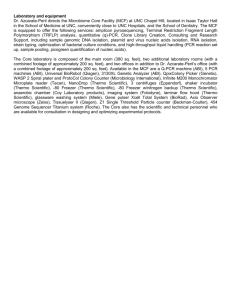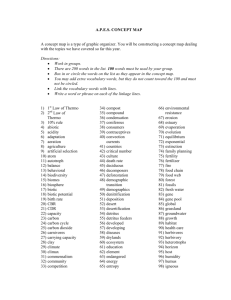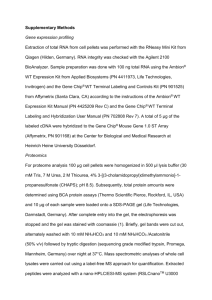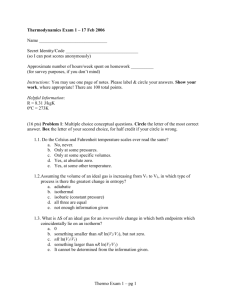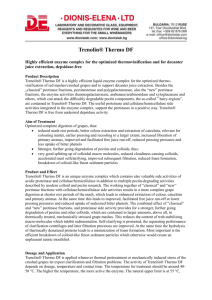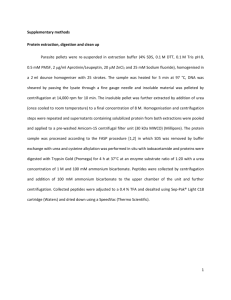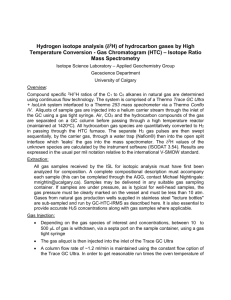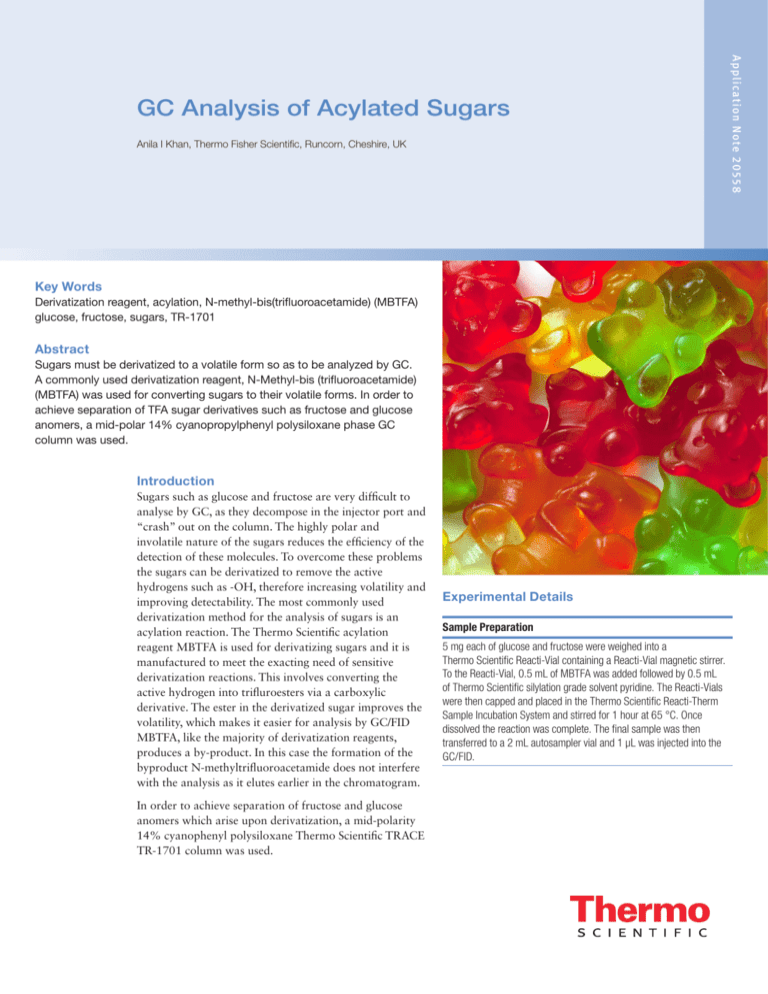
Anila I Khan, Thermo Fisher Scientific, Runcorn, Cheshire, UK
Key Words
Derivatization reagent, acylation, N-methyl-bis(trifluoroacetamide) (MBTFA)
glucose, fructose, sugars, TR-1701
Abstract
Sugars must be derivatized to a volatile form so as to be analyzed by GC.
A commonly used derivatization reagent, N-Methyl-bis (trifluoroacetamide)
(MBTFA) was used for converting sugars to their volatile forms. In order to
achieve separation of TFA sugar derivatives such as fructose and glucose
anomers, a mid-polar 14% cyanopropylphenyl polysiloxane phase GC
column was used.
Introduction
Sugars such as glucose and fructose are very difficult to
analyse by GC, as they decompose in the injector port and
“crash” out on the column. The highly polar and
involatile nature of the sugars reduces the efficiency of the
detection of these molecules. To overcome these problems
the sugars can be derivatized to remove the active
hydrogens such as -OH, therefore increasing volatility and
improving detectability. The most commonly used
derivatization method for the analysis of sugars is an
acylation reaction. The Thermo Scientific acylation
reagent MBTFA is used for derivatizing sugars and it is
manufactured to meet the exacting need of sensitive
derivatization reactions. This involves converting the
active hydrogen into trifluroesters via a carboxylic
derivative. The ester in the derivatized sugar improves the
volatility, which makes it easier for analysis by GC/FID
MBTFA, like the majority of derivatization reagents,
produces a by-product. In this case the formation of the
byproduct N-methyltrifluoroacetamide does not interfere
with the analysis as it elutes earlier in the chromatogram.
In order to achieve separation of fructose and glucose
anomers which arise upon derivatization, a mid-polarity
14% cyanophenyl polysiloxane Thermo Scientific TRACE
TR-1701 column was used.
Experimental Details
Sample Preparation
5 mg each of glucose and fructose were weighed into a
Thermo Scientific Reacti-Vial containing a Reacti-Vial magnetic stirrer.
To the Reacti-Vial, 0.5 mL of MBTFA was added followed by 0.5 mL
of Thermo Scientific silylation grade solvent pyridine. The Reacti-Vials
were then capped and placed in the Thermo Scientific Reacti-Therm
Sample Incubation System and stirred for 1 hour at 65 °C. Once
dissolved the reaction was complete. The final sample was then
transferred to a 2 mL autosampler vial and 1 μL was injected into the
GC/FID.
Appli cat i on N ote 2 0 5 5 8
GC Analysis of Acylated Sugars
2
Reagents
Part Number
Thermo Scientific MBTFA 10 × 1 mL ampules
TS-49700
Thermo Scientific pyridine silylation grade solvent
TS-27530
Sample Handling Equipment
Part Number
Thermo Scientific Reacti-Therm III Heating/Stirring Module
TS-18823
Thermo Scientific Reacti-Vap III Evaporator
TS-18826
Thermo Scientific Reacti-Block Q-1 (Holds 8 × 10 mL Reacti-Vials) TS-18814
Thermo Scientific Reacti-Vial clear glass reaction vials 10 mL TS-13225
Thermo Scientific 2 mL amber vial and screw tops Separation Conditions
60180-565
Part Number
Instrumentation:
Thermo Scientific TRACE GC Ultra
Column: TRACE™ TR-1701
30 m × 0.25 mm × 0.25 μm
Thermo Scientific BTO 17 mm septa
260Q142P
31303211
5 mm ID focus split liner, 105 mm long
453T1905
Graphite liner seal
29033406
10 μL, 50 mm needle length gauge 25 Syringe
36500525
Graphite ferrules to fit 0.1-0.25 mm ID columns
29053488
Carrier gas:
Helium
Split flow:
60 mL/min
Column flow: 1.2 mL/min, Constant flow
Split ratio: 50:1
Oven temperature: 40 °C (1 min), 10 °C/min, 260 °C (5 min)
Injector type: Split/Splitless
Injector mode: Split
Injector temperature: 200 °C
Detector type: FID
Detector temperature: 250 °C
Detector Hydrogen flow: 35 mL/min
Detector Air flow: 350 mL/min
Detector Nitrogen flow: 30 mL/min
Thermo Scientific TriPlus Autosampler
Injection Volume: Data Processing
Software:
1 μL
Thermo Scientific XCalibur
O
OH
CF3
O
OH
Results
O
N
CH2OTFA
CF3
O
CH3
OH
OH
OTFA
(MBTFA)
OTFA
Pyridine
OTFA
OTFA
Figure 1: Acylation of glucose with MBTFA and pyridine
2000
The derivatized glucose produced two peaks,
corresponding to the two cyclic forms of glucose existing
as anomers (Figure 1) and fructose gave rise to one peak.
Good baseline separation between fructose and the two
anomers of derivatized glucose was observed (Figure 2)
using a 14% cyanophenyl polysiloxane phase column.
The stability of the sugars is improved as the acylation
reagent protects the unstable groups, aiding separation on
the chromatographic column.
Conclusion
MBTFA is an ideal derivatization reagent for increasing
the volatility of sugars. This enabled enhanced separation
and detection of fructose and glucose anomers using a
TRACE TR-1701 GC column.
Millivolts
1
2
References
1000
Thermo Scientific reagents, solvents and accessories
brochure (Ref: BR20535_E06/12). Available upon
request. ACD labs software to draw chemical structures.
2
0
14
16
18
Minutes
Figure 2: Chromatogram of the separation of derivatized sugars
on a TR-1701 column.
Peak Number
Sugar
tR (min)
1
Fructose
16.0
2
Glucose anomers
16.1 and 17.0
thermoscientific.com/chromatography
©2014 Thermo Fisher Scientific Inc. All rights reserved. All trademarks are the property of Thermo Fisher Scientific and its subsidiaries.
This information is presented as an example of the capabilities of Thermo Fisher Scientific products. It is not intended to encourage use of
these products in any manners that might infringe the intellectual property rights of others. Specifications, terms and pricing are subject to change.
Not all products are available in all countries. Please consult your local sales representative for details.
USA and Canada +1 800 332 3331
Australia 1300 735 292 (free call domestic)
China 800 810 5118 (free call domestic)
400 650 5118
France +33 (0)1 60 92 48 34
Germany +49 (0) 2423 9431 20 or 21
India +91 22 6742 9494
+91 27 1766 2352
AN20558-EN 1114S
Japan 0 120 753 670 (free call domestic)
0120 753 671 (fax)
Korea +82 2 3420 8600
United Kingdom +44 (0) 1928 534 110
New Zealand 0800 933 966 (free call domestic)
Singapore +65 6289 1190
All Other Enquiries +44 (0) 1928 534 050
Technical Support
For advice and support, please visit our website:
www.thermoscientific.com/chromexpert
Appli cat i on N ote 2 0 5 5 8
CH2OH

